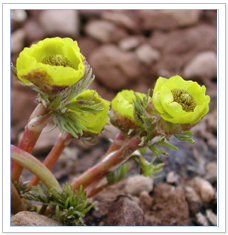Candace Galen

Emeritus Professor
Division of Biological Sciences
E-mail: galenc at missouri dot edu
Office address: 216 Tucker Hall
Office phone: 573-882-4832
Lab phone: 573-882-7399

My research program explores the mechanisms and processes of evolution in wild plant populations. Over the past decade I have drawn on a diverse group of flowering plants to study the ecological and evolutionary consequences of variation in life history traits and reproductive characters. I am currently involved in two major projects continuing this line of research. The first addresses how conflicting selection pressures shape the evolution of floral traits within natural populations of alpine Polemonium viscosum (skypilot). This project represents an integrated study of the genetics, ecology, ecophysiology and evolution of flower size and form.
A second interest concerns the physiological and genetic basis of solar tracking or flower heliotropism using the snow buttercup, Ranunculus adoneus, as a model system. This research, conducted in collaboration with the Liscum lab, addresses the genetic relationship between solar tracking in flowers and phototropism in seedlings. The ultimate goal is to determine whether the two processes are genetically correlated and/or controlled by members of the same gene family. If so, selection on one process might influence the evolution of the other in natural populations. Molecular and quantitative genetic approaches are being used to explore this hypothesis.
In answering evolutionary questions, evidence from many levels of biological organization is helpful. Work in my lab draws on populational, organismal and physiological observations to measure plant performance and natural selection. The synthesis of ecological and genetic approaches adopted in these studies offers insights into the mechanisms and tempo of microevolutionary events. Knowledge gained in this domain also has applied value. Our efforts to conserve native flora depend ultimately on our knowledge of their potential to adapt to new environmental challenges. Our ability to grow crops sustainably depends on an understanding of the physiological and morphological modifications that allow plant species to grow and reproduce under stressful ecological conditions. Insights into both kinds of questions may be found by studying the ecological genetics of native flora in natural environments.
- Faculty Fellow, Difficult Dialogues Faculty Development Program (2007)
- AAAS Fellow (2004)
McCaffrey J, and Galen C. Between a rock and a hard place: Impact of nest selection behavior on the altitudinal range of an alpine ant, Formica neorufibarbis. Environmental Entomology 2011;40(3):534-540.
Galen C, Kaczorowski R, Todd SL, Geib J, andRaguso RA. Dosage-dependent impacts of a floral volatile compound on pollinators, larcenists, and the potential for floral evolution in the alpine skypilot polemonium viscosum. American Naturalist 2011;177(2):258-272.
Galen C, Stanton ML. Sunny-side up: flower heliotropism as a source of parental environmental effects on pollen quality and performance in the snow buttercup, Ranunculus adoneus (Ranunculaceae). American Journal of Botany 2003;90:724–29.
Galen C, Huddle J, and Liscum E. An experimental test of the adaptive evolution of phototropins: blue light photoreceptors controlling phototropism in Arabidopsis thaliana. Evolution 2004;58:515–523.
Brock MT, Weinig C, and Galen C. A comparison of phenotypic plasticity in the native dandelion, Taraxacum ceratophorum and its invasive congener, T. officinale. New Phytologistist 2005;166:173–83.
Campbell DR, Galen C, and Wu CA. Ecophysiology of first and second generation hybrids in a natural plant hybrid zone. Oecologia 2005;144(2):214–25.
Brock MT and Galen C. Drought tolerance in the alpine dandelion, Taraxacum ceratophorum, (Asteraceae), its exotic congener T. officinale, and interspecific hybrids under natural and experimental conditions. American Journal of Botany 2005;92:1311–21.
Galen C. Solar furnaces or swamp coolers: costs and benefits of water use by solar tracking flowers of the alpine snow buttercup, Ranunculus adoneus. Oecologia 2006;148(2):195–01.
Galen C, Rabenold JJ, and Liscum E. The functional ecology of a blue light photoreceptor: effects of phototropin-1 on: root growth enhance drought tolerance in Arabidopsis thaliana. New Phytologist 2006;173(1):91–99.
Galen C and Geib JC. Conditions for evolution in a pollination mutualism: density dependent effects of nectar-thieving ants on selection for bumblebee pollination in the alpine wildflower, Polemonium viscosum. Ecology 2007;88(5):1202–09.
Dudley LS and Galen C. Stage-dependent patterns of drought tolerance and gas exchange vary between sexes in the alpine willow, Salix glauca. Oecologia 2007;153(1):1–9.
Becklin K and Galen C. Intra- and interspecific variation in mycorrhizal association across a heterogeneous habitat gradient in alpine plant communities. Arctic, Antarctic, and Alpine Research 2009;41(2):183-190.